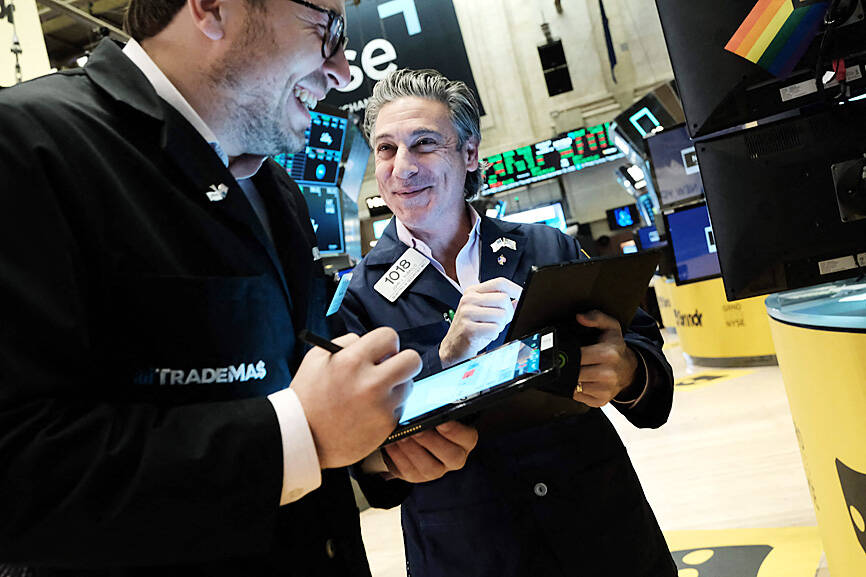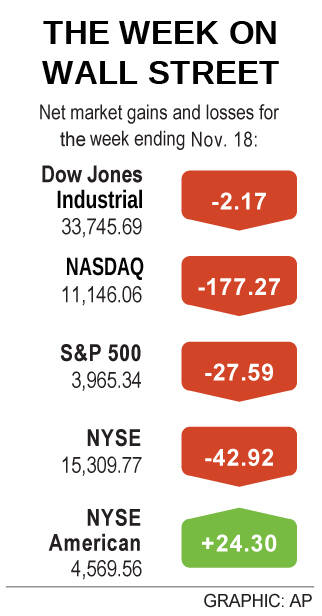Wall Street’s benchmark S&P 500 index on Friday ended higher in a choppy trading session, as gains in defensive shares overshadowed energy declines, and investors shrugged off hawkish comments from US Federal Reserve officials about interest rate hikes.
Federal Reserve Bank of Boston President Susan Collins said that, with little evidence price pressures are waning, the Fed might need to deliver another 75 basis-point rate hike as it seeks to get inflation under control.
On Thursday, St Louis Fed President James Bullard set off equity declines when he said that the Fed needs to keep raising interest rates given that its tightening so far “had only limited effects on observed inflation.”

Photo: AFP
With Collins and then Bullard “we have had some very hawkish talk, but the market has really taken it in stride,” Trust Advisory Services cochief investment officer Keith Lerner said. “It hasn’t hit the market to the downside like it has in the past.”
The Dow Jones Industrial Average rose 199.37 points, or 0.59 percent, to 33,745.69, the S&P 500 gained 18.78 points, or 0.48 percent, to 3,965.34 and the NASDAQ Composite added 1.1 points, or 0.01 percent, to 11,146.06.
For the week, the S&P 500 fell 0.69 percent, retreating modestly after a month-long rally spurred by softer-than-expected inflation data that sparked hopes the central bank could temper its market-punishing rate hikes.

The NASDAQ fell 1.6 percent for the week, while the Dow was basically unchanged, dipping 0.01 percent.
“Markets are in a bit of a holding pattern” ahead of employment and other economic data, New York Life Investments economist and portfolio strategist Lauren Goodwin said.
“What is driving all equities of course is Fed policy and the gravitational force that rising interest rates have on the equity complex as a whole,” Goodwin said. “We are not likely to see any real evidence in terms of potentially declining wage pressure or inflation pressure for another couple of weeks.”
Defensive groups led the way among S&P 500 sectors, with utilities up 2 percent, real estate rising 1.3 percent and healthcare 1.2 percent higher.
The energy sector fell 0.9 percent, as oil prices dropped, stemming from concern about weakened demand in China and further increases to US interest rates.
Advancing issues outnumbered declining ones on the NYSE by a 1.54-to-1 ratio; on the NASDAQ, a 1.13-to-1 ratio favored advancers.
The S&P 500 posted eight new 52-week highs and three new lows, while the NASDAQ Composite recorded 62 new highs and 141 new lows.
About 9.7 billion shares changed hands on US exchanges, compared with the 12 billion daily average over the past 20 sessions.

Intel Corp chief executive officer Lip-Bu Tan (陳立武) is expected to meet with Taiwanese suppliers next month in conjunction with the opening of the Computex Taipei trade show, supply chain sources said on Monday. The visit, the first for Tan to Taiwan since assuming his new post last month, would be aimed at enhancing Intel’s ties with suppliers in Taiwan as he attempts to help turn around the struggling US chipmaker, the sources said. Tan is to hold a banquet to celebrate Intel’s 40-year presence in Taiwan before Computex opens on May 20 and invite dozens of Taiwanese suppliers to exchange views

Application-specific integrated circuit designer Faraday Technology Corp (智原) yesterday said that although revenue this quarter would decline 30 percent from last quarter, it retained its full-year forecast of revenue growth of 100 percent. The company attributed the quarterly drop to a slowdown in customers’ production of chips using Faraday’s advanced packaging technology. The company is still confident about its revenue growth this year, given its strong “design-win” — or the projects it won to help customers design their chips, Faraday president Steve Wang (王國雍) told an online earnings conference. “The design-win this year is better than we expected. We believe we will win

Chizuko Kimura has become the first female sushi chef in the world to win a Michelin star, fulfilling a promise she made to her dying husband to continue his legacy. The 54-year-old Japanese chef regained the Michelin star her late husband, Shunei Kimura, won three years ago for their Sushi Shunei restaurant in Paris. For Shunei Kimura, the star was a dream come true. However, the joy was short-lived. He died from cancer just three months later in June 2022. He was 65. The following year, the restaurant in the heart of Montmartre lost its star rating. Chizuko Kimura insisted that the new star is still down

While China’s leaders use their economic and political might to fight US President Donald Trump’s trade war “to the end,” its army of social media soldiers are embarking on a more humorous campaign online. Trump’s tariff blitz has seen Washington and Beijing impose eye-watering duties on imports from the other, fanning a standoff between the economic superpowers that has sparked global recession fears and sent markets into a tailspin. Trump says his policy is a response to years of being “ripped off” by other countries and aims to bring manufacturing to the US, forcing companies to employ US workers. However, China’s online warriors